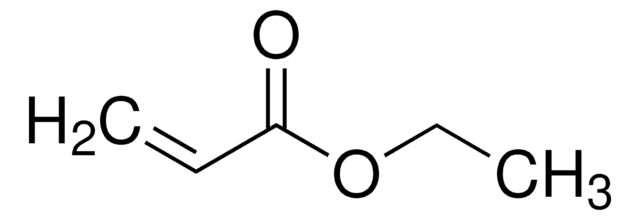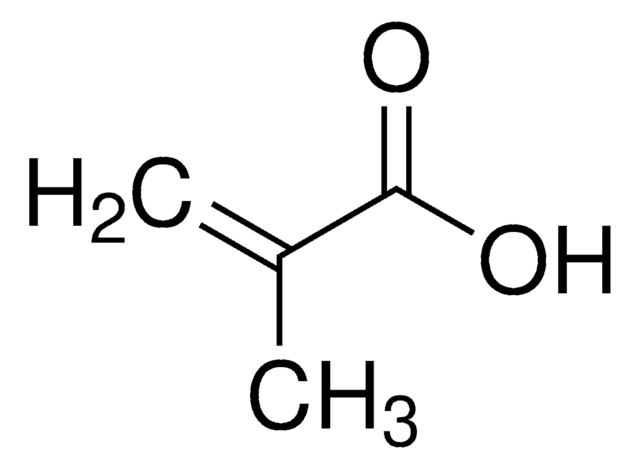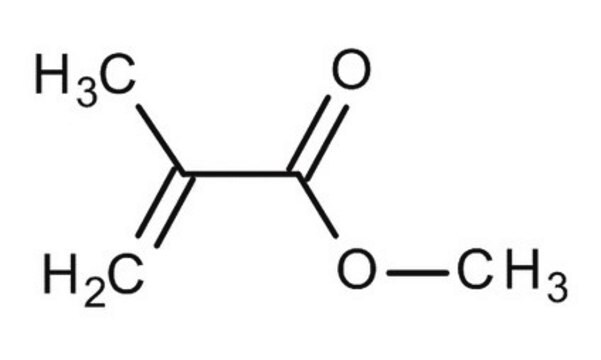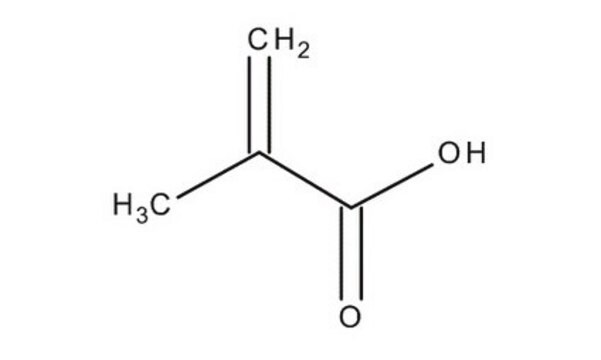W241811
Ethyl acrylate
≥99.5%, stabilized
Sinónimos:
Acrylic acid ethyl ester, Ethyl 2-propenoate
About This Item
Productos recomendados
origen biológico
synthetic
Nivel de calidad
grado
Kosher
cumplimiento norm.
FDA 21 CFR 117
densidad de vapor
3.5 (vs air)
presión de vapor
31 mmHg ( 20 °C)
Análisis
≥99.5%
formulario
liquid
temp. de autoignición
721 °F
contiene
10-30 ppm MEHQ as stabilizer (synthetic)
lim. expl.
12.1 %
índice de refracción
n20/D 1.406 (lit.)
bp
99 °C (lit.)
mp
−71 °C (lit.)
densidad
0.918 g/mL at 25 °C (lit.)
aplicaciones
flavors and fragrances
Documentación
see Safety & Documentation for available documents
alérgeno alimentario
no known allergens
Organoléptico
plastic
cadena SMILES
CCOC(=O)C=C
InChI
1S/C5H8O2/c1-3-5(6)7-4-2/h3H,1,4H2,2H3
Clave InChI
JIGUQPWFLRLWPJ-UHFFFAOYSA-N
¿Está buscando productos similares? Visita Guía de comparación de productos
Descripción general
Aplicación
- Refractive index adjustable intraocular lens design to achieve diopter control for improving the treatment of ametropia after cataract surgery.: This study involves the use of ethyl acrylate in developing intraocular lenses with adjustable refractive indices, which aims to improve visual outcomes in patients undergoing cataract surgery by providing customizable diopter control (Hong et al., 2024).
Cláusula de descargo de responsabilidad
Palabra de señalización
Danger
Frases de peligro
Consejos de prudencia
Clasificaciones de peligro
Acute Tox. 3 Inhalation - Acute Tox. 4 Dermal - Acute Tox. 4 Oral - Aquatic Chronic 3 - Eye Irrit. 2 - Flam. Liq. 2 - Skin Irrit. 2 - Skin Sens. 1 - STOT SE 3
Órganos de actuación
Respiratory system
Código de clase de almacenamiento
3 - Flammable liquids
Clase de riesgo para el agua (WGK)
WGK 2
Punto de inflamabilidad (°F)
48.2 °F - closed cup
Punto de inflamabilidad (°C)
9 °C - closed cup
Elija entre una de las versiones más recientes:
¿Ya tiene este producto?
Encuentre la documentación para los productos que ha comprado recientemente en la Biblioteca de documentos.
Los clientes también vieron
Nuestro equipo de científicos tiene experiencia en todas las áreas de investigación: Ciencias de la vida, Ciencia de los materiales, Síntesis química, Cromatografía, Analítica y muchas otras.
Póngase en contacto con el Servicio técnico










